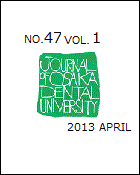Volume 42, Issue 1
Displaying 1-13 of 13 articles from this issue
- |<
- <
- 1
- >
- >|
-
Article type: Article
2008 Volume 42 Issue 1 Pages 1-7
Published: 2008
Released on J-STAGE: December 22, 2016
Download PDF (1716K) -
Article type: Article
2008 Volume 42 Issue 1 Pages 9-15
Published: 2008
Released on J-STAGE: December 22, 2016
Download PDF (1859K) -
Article type: Article
2008 Volume 42 Issue 1 Pages 17-26
Published: 2008
Released on J-STAGE: December 22, 2016
Download PDF (1046K) -
Article type: Article
2008 Volume 42 Issue 1 Pages 27-34
Published: 2008
Released on J-STAGE: December 22, 2016
Download PDF (1079K) -
Article type: Article
2008 Volume 42 Issue 1 Pages 35-42
Published: 2008
Released on J-STAGE: December 22, 2016
Download PDF (772K) -
Article type: Article
2008 Volume 42 Issue 1 Pages 43-49
Published: 2008
Released on J-STAGE: December 22, 2016
Download PDF (741K) -
Article type: Article
2008 Volume 42 Issue 1 Pages 51-56
Published: 2008
Released on J-STAGE: December 22, 2016
Download PDF (999K) -
Article type: Article
2008 Volume 42 Issue 1 Pages 57-62
Published: 2008
Released on J-STAGE: December 22, 2016
Download PDF (551K) -
Article type: Article
2008 Volume 42 Issue 1 Pages 63-70
Published: 2008
Released on J-STAGE: December 22, 2016
Download PDF (719K) -
Article type: Article
2008 Volume 42 Issue 1 Pages 71-74
Published: 2008
Released on J-STAGE: December 22, 2016
Download PDF (352K) -
Article type: Article
2008 Volume 42 Issue 1 Pages 75-82
Published: 2008
Released on J-STAGE: December 22, 2016
Download PDF (749K) -
Article type: Article
2008 Volume 42 Issue 1 Pages 83-87
Published: 2008
Released on J-STAGE: December 22, 2016
Download PDF (1794K) -
Article type: Article
2008 Volume 42 Issue 1 Pages 89-93
Published: 2008
Released on J-STAGE: December 22, 2016
Download PDF (1394K)
- |<
- <
- 1
- >
- >|
